The Brazos Review: AMD's E-350 Supplants ION for mini-ITX
by Anand Lal Shimpi on January 27, 2011 6:08 PM ESTDiscrete GPUs on Brazos: CPU and PCIe Bound
Intel's Atom could use a more capable GPU, but what about Brazos? The E-350's GPU is branded the AMD Radeon HD 6310. It has a total of 80 VLIW-5 SPs running at 500MHz. The GPU shares the same 64-bit DDR3 memory interface as the CPU, but it does not have any access to the CPU's caches. Future incarnations of Fusion will blur the line between the CPU and GPU but for now, this is the division.
Branching off the E-350 APU are four PCIe lanes. There are another four lanes courtesy of the Hudson FCH. MSI's E350IA-E45 exposes the former by the way of a physical PCIe x16 slot, although electrically it's only a x4. Curious to see if there would be any benefit to plugging in a faster GPU I decided to try a Radeon HD 5450 and 5570 in the slot:
With a couple of exceptions (World of Warcraft, HAWX), there's no real benefit to a discrete Radeon HD 5450 over the integrated Radeon HD 6310. This is unsurprising as the two have very similar compute capabilities and only differ in the amount of available memory bandwidth since the Radeon HD 5450 doesn't have to share with a neighboring CPU.
The Radeon HD 5570 results were a bit unexpected. Other than Modern Warfare 2 and BioShock 2, there's little performance difference between the 5570 and the 5450 when paired with the AMD E-350. How much of this is due to the performance of the E-350 vs. the bandwidth limitations of the PCIe x4 slot is difficult to say. This smells like a CPU limitation, in which case it would mean that AMD didn't skimp at all when it came to the E-350's GPU.
The Radeon HD 6310: Very Good for the Money
I want to say that lately we've seen a resurgence in the importance of integrated graphics, but I don't know that it ever was truly important. With both AMD and Intel now taking processor graphics seriously, the quality and performance of what we get "for free" should go up tremendously in the coming years. The past two years have shown us that Intel is starting to take GPU performance seriously. The HD Graphics, HD Graphics 2000 and 3000 parts we've been given are all relatively competitive. The only problem is you generally have to spend around $100 - $200 on a CPU to get what I'd consider the bare minimum you should get from integrated graphics. Brazos aims to change that.
The E-350 still isn't enough to play all modern games, but it's what I would consider an acceptable entry level GPU. Despite its stature, the E-350 can easily compete with much more expensive Intel solutions when it comes to 3D gaming. Let's get to the numbers.
Dragon Age: Origins
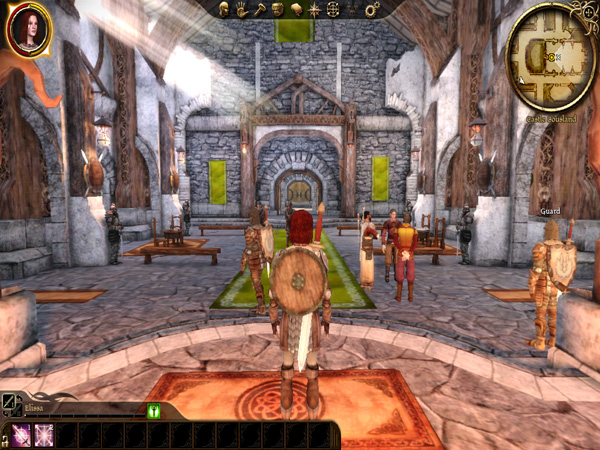
DAO has been a staple of our integrated graphics benchmark for some time now. The third/first person RPG is well threaded and is influenced both by CPU and GPU performance.
We ran at 1024 x 768 with graphics and texture quality both set to low. Our benchmark is a FRAPS runthrough of our character through a castle.
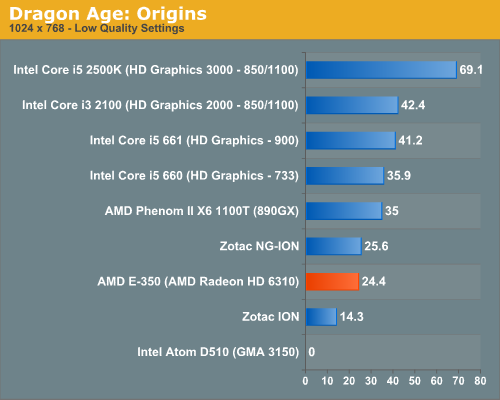
Our Dragon Age: Origins benchmark is quite CPU bound here and thus the E-350's Radeon HD 6310 doesn't look all that powerful. Luckily for AMD, DAO happens to be more of an outlier among current games as you're about to see.
The bare bones Atom D510 won't even run DAO. You'll see a number of games where compatibility is a problem for the D510. NVIDIA's ION does a lot better but it'll take a second generation ION to hang with the E-350. Zotac's NG-ION is actually a bit faster than the E-350, implying some driver/threading efficiencies as we're most definitely CPU bound on these low end parts.
Dawn of War II

Dawn of War II is an RTS title that ships with a built in performance test. I ran at the lowest quality settings at 1024 x 768.
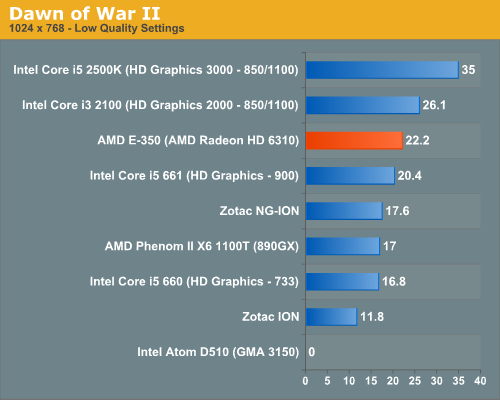
Oh what a difference moving a bottleneck makes. The AMD E-350, with its 75mm2 die is faster than Intel's Core i5 661 - the fastest implementation of Intel's HD Graphics. The E-350's performance isn't too far off the Core i3 2100 either. While none of these frame rates are what I'd call smooth, you can't argue with how competitive the E-350 is here.
Call of Duty: Modern Warfare 2

Our Modern Warfare 2 benchmark is a quick FRAPS run through a multiplayer map. All settings were turned down/off and we ran at 1024 x 768.
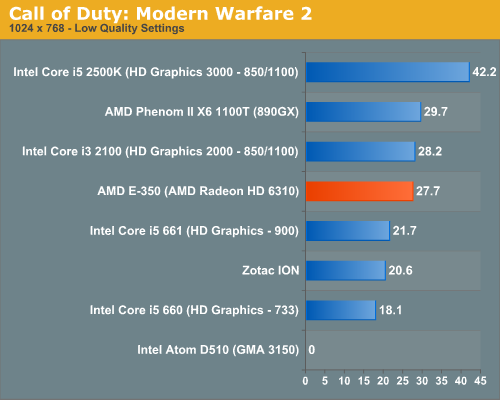
Modern Warfare 2 paints an even better picture for AMD. The E-350 offers virtually the same performance as Intel's Core i3 2100, and noticeably better performance than the Core i5 661. Need I mention that you get this at a much lower price than either of the aforementioned CPUs?
BioShock 2
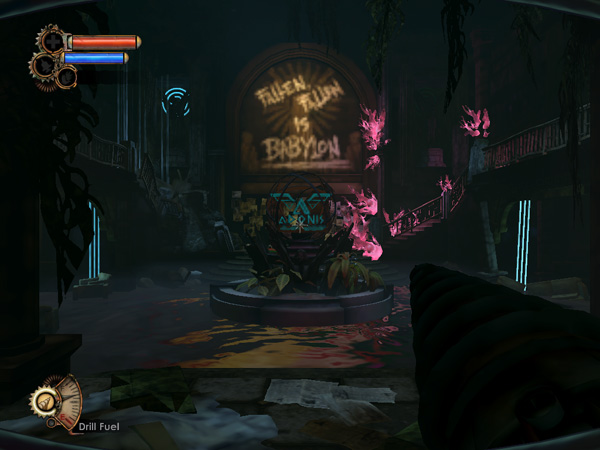
Our test is a quick FRAPS runthrough in the first level of BioShock 2. All image quality settings are set to low, resolution is at 1024 x 768.

Again the E-350 continues to hang with the best here. The frame rates are still not high enough to get excited, but the effort is top notch.
World of Warcraft
Our WoW test is run at fair quality settings (with weather turned down all the way) on a lightly populated server in an area where no other players are present to produce repeatable results. We ran at 1024 x 768.
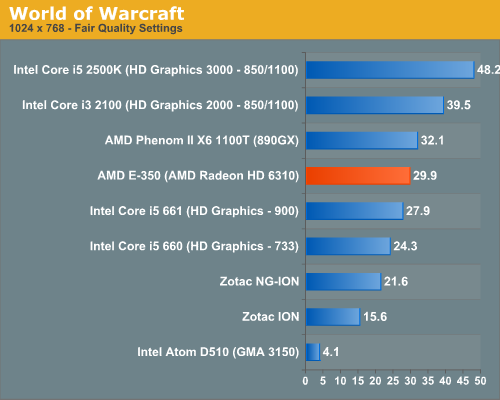
AMD's E-350 is faster than anything from the Clarkdale era, while just a bit slower than AMD's 890GX. Intel's HD Graphics 2000 is faster but at a much higher power consumption and pricetag of course. Intel's Atom D510 can complete our benchmark here but at a laughable 4.1 fps. Both the first and second generation ION platforms fall behind Brazos.
HAWX
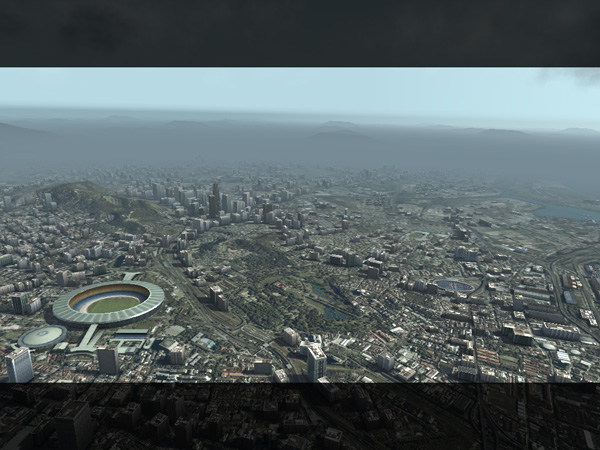
Our HAWX performance tests were run with the game's built in benchmark in DX10 mode. All detail settings were turned down/off and we ran at 1024 x 768.
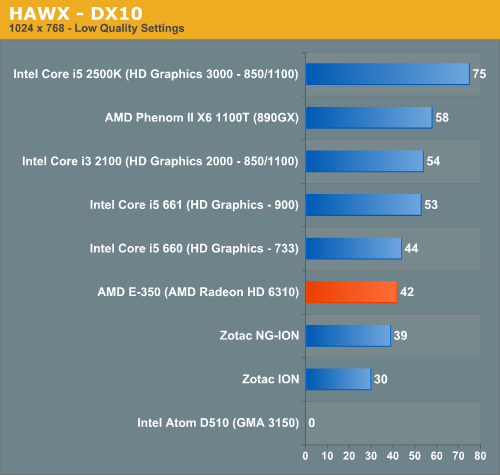
With HAWX CPU performance matters a bit more, pushing the E-350 just slightly behind the Core i5 660. The Radeon HD 6310 still delivers respectable performance in HAWX, especially considering its price point. The next-generation ION does come close in performance to the E-350, while the original ION is significantly slower.
Starcraft II

We have two Starcraft II benchmarks: a GPU and a CPU test. The GPU test is mostly a navigate-around-the-map test, as scrolling and panning around tends to be the most GPU bound in the game. Our CPU test involves a massive battle of 6 armies in the center of the map, stressing the CPU more than the GPU. At these low quality settings however, both benchmarks are influenced by CPU and GPU.
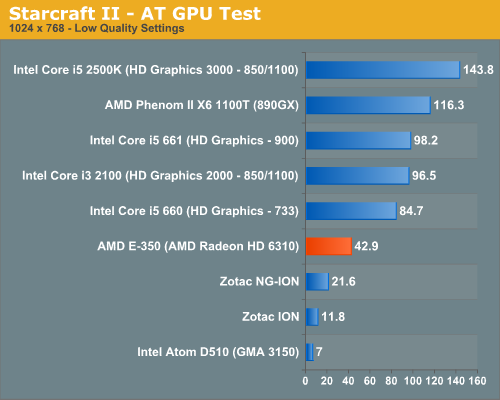
In our GPU specific test, the E-350 is significantly faster than anything Atom based. While the D510 can technically run this test, it does so at only 7 fps. Even the next-generation ION only manages 21.6 fps. The E-350 with its Radeon HD 6310 delivers nearly twice the frame rate of the fastest ION. The advantage isn't purely on the GPU side. As I mentioned before, Starcraft II can be very CPU bound at times. The Bobcat cores at work in the E-350 help give it a significant advantage over anything paired with Atom.
The CPU dependency is what separates the E-350 from its larger, more expensive competitors here. The gap only widens as we look at what happens in a big battle:
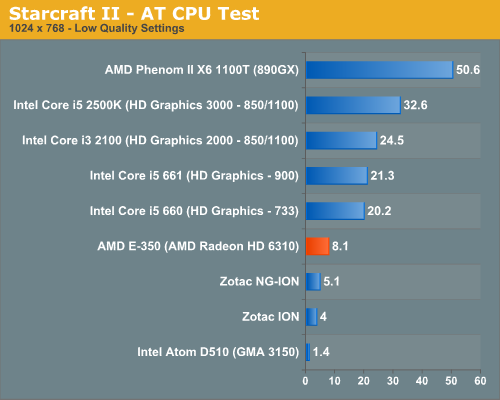
While you can play Starcraft II on any of these systems, to maintain frame rate throughout all scenarios you really need more CPU and GPU horsepower.
Call of Duty: Black Ops
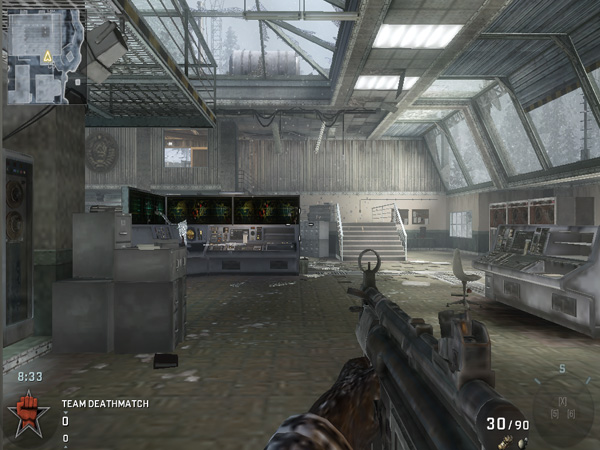
Our Black Ops test is a quick FRAPS runthrough on a private multiplayer server. The game was set to 1024 x 768 at the lowest quality settings.
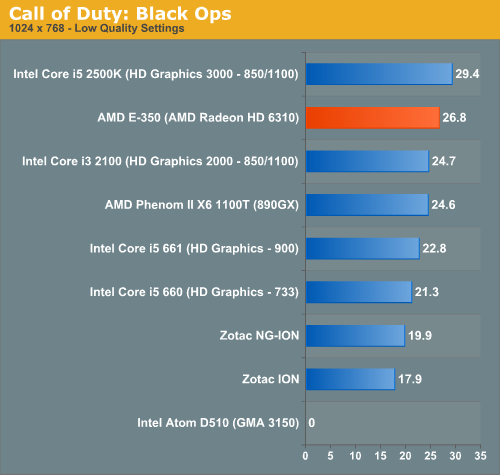
In Black Ops the E-350 does the best it has done thus far, nearly equaling the performance of Intel's HD Graphics 3000. In our Sandy Bridge Review I wondered if Intel was being limited by driver issues here as there's very little difference between the 3000 and 2000 GPUs. The E-350 benefits from all of the driver tweaks and experience AMD has from the Radeon side so it immediately puts its best foot forward. AMD's greatest ally in Fusion will be its driver experience.
Mafia II
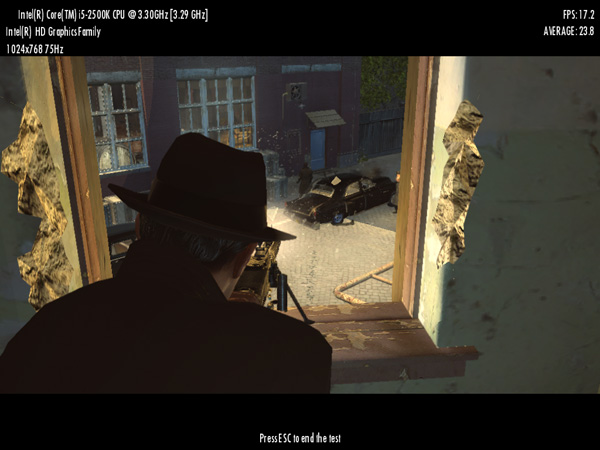
Mafia II ships with a built in benchmark which we used for our comparison:
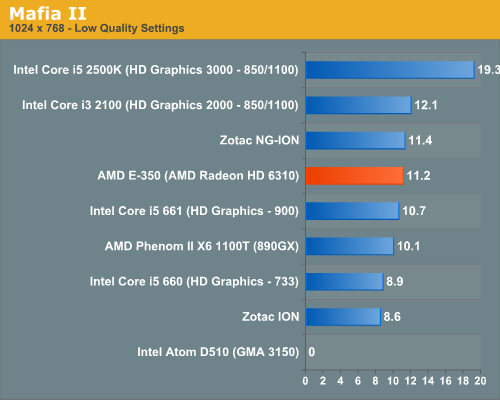
Mafia II doesn't run well on any integrated graphics platform, regardless of vendor. The E-350 does well vs. the competition but none of these platforms are playable, even at the lowest settings.
Civilization V
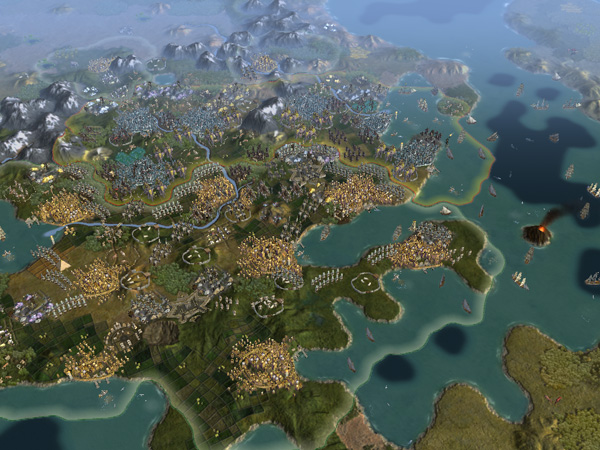
For our Civilization V test we're using the game's built in lateGameView benchmark. The test was run in DX9 mode with everything turned down at 1024 x 768:
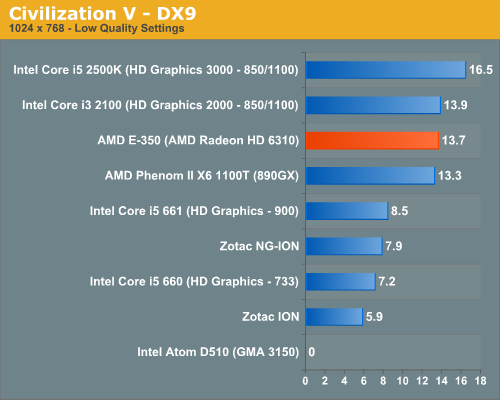
Civilization V doesn't run well on any integrated graphics platform, but the E-350 runs it at least as well (or as poorly?) as Intel's Core i3 2100. The Bobcat cores help with a lot of the heavy lifting here giving the E-350 a substantial lead over Atom.
Metro 2033
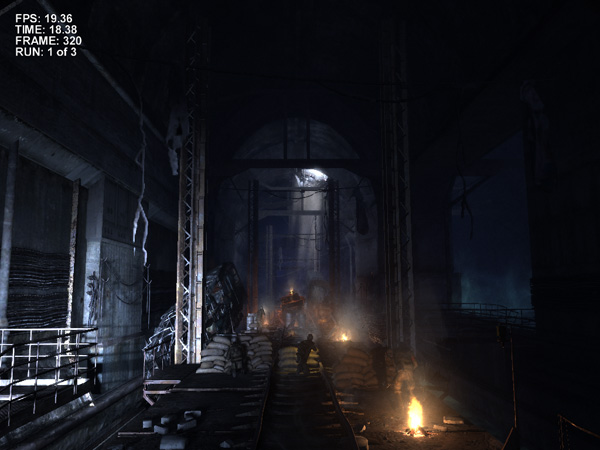
We're using the Metro 2033 benchmark that ships with the game.
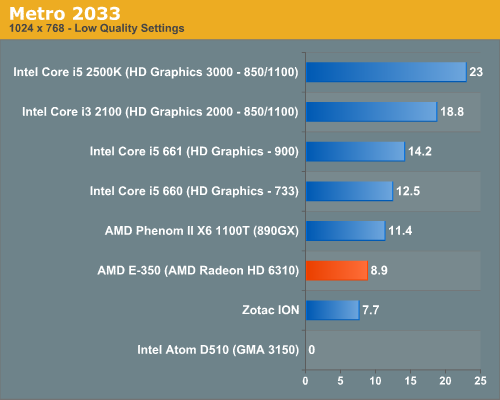
Metro 2033 is a bit too modern for these low end platforms. The E-350 is faster than ION but not in the realm of playability.
DiRT 2
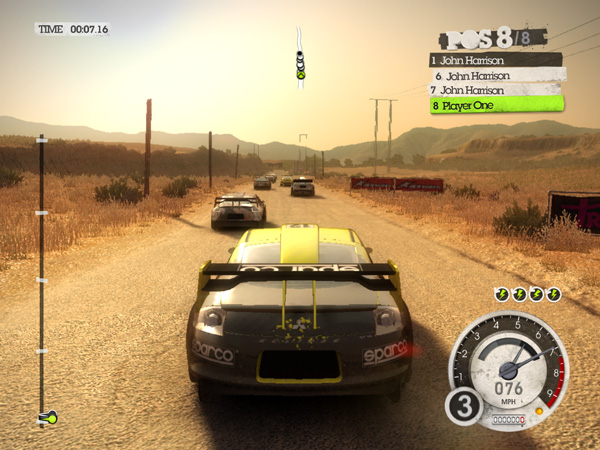
Our DiRT 2 performance numbers come from the demo's built-in benchmark:
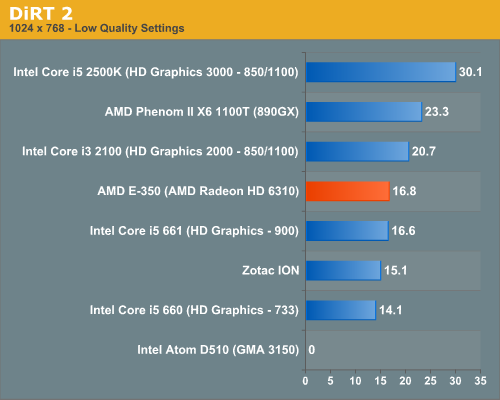


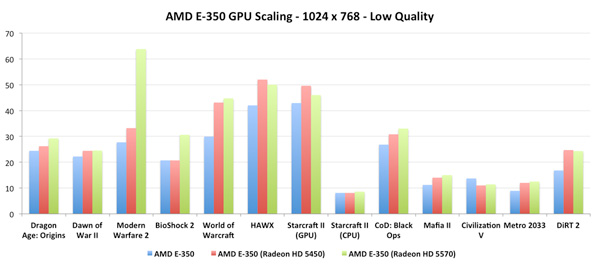








176 Comments
View All Comments
ocre - Friday, January 28, 2011 - link
hahaha, You need to educate yourself a little more on the advantages/disadvantages of both the x86 and ARM architectures before you go around posting ignorant statements like these. If we assumed your statement: is true: "E-350 has roughly 5 times the performance of Tegra 2" it would still be nothing to brag on becaue the same tegra 2 uses 7-9 times less energy than the E-350. This makes a mere 5 time performance a joke.But on top of that, there is no good reasonable way to conclude where these architectures rate towards one another. The software is radically different. There is not enough to go on for any useful conclusion and what little we do have is subject to a very special cases where there is SW that in the end results to similar obtained data. But the entire process is different and while we know the x86 is pretty well optimized, any ARM based counter SW is in its beginnings. X86 has the luxury of optimizations, ARM will only get better when SW engineers find better ways to utilize the system. But this is considering an actual case where there is SW similar enough to even reasonably attempt to measure x86 vs ARM performance. For the most part there the SW of each architecture is so radically different. ARM is extremely good at some things and not so good at others and this doesnt mean it cant be good, in some cases the SW just hasnt matured yet. All this matters little cause at the end of the day, everyone can see that the exact opposite from your statement; The superiority of ARM is just unmatched by x86 when it comes to performance per watt. This is undisputed and x86 has a long long way to go to catch up with arm (and many think it never will). Alls Arm has to do is actually build 18w CPUs, they will be 3 to 4 times more powerful than the e-350 based on the current ARM architecture.
jollyjugg - Friday, January 28, 2011 - link
Well your last statement is simply laughable. Because all we have from ARM right now is chips which run in smartphones and tablets. ARM based processors are not exactly known for their performance as much as their power. While it is true that performance/watt is great in ARM today, it also true as any modern microprocessor designer would say that, as you go up the performance chain (by throwing more hardware and getting more giga Hz and other tweaks like wider issue and out of order etc), the mileage you get out of the machine improves so does the drop in performance/watt. There are no free lunches here. I doubt a good performance ARM architecture will be a whole lot different that an x86 architecure. While the lower power is an achilles heal for x86 as is the performance an achilles heal for ARM. You mentioned software maturity. It is laughable to even mention this in this cut throat industry. Intel showed its superiority over AMD by tweaking the free x86 compiler it gave away to developers to suit its x86 architecture compared to its rival and the users got cheated until European commision exposed Intel. So dont even talk about software maturity. The incumbant always has the advantage. ARM first has to kill Intel's OEM muscle and marketing muscle before it can start dominating. Even if it did the former two, there is something it can never do, which is matching intel's manufacturing muscle. Intel by far is way better than even the largest contract manufacturer TSMC whose only task is to manufacture.Shadowmaster625 - Monday, January 31, 2011 - link
Nonsense. ARM is more optimized that x86. x86 code is always sloppy, because it has always been designed without having to deal with RAM, ROM, and clock constraints. When you code for an ARM device, you are presented with limits that most software engineers never even faced when writing x86 code. When writing software for Windows, 99.9% of developers will tell you they never even think about the amount of RAM they are using. For ARM it was probably 80% 10 years ago. Today it is probably less than 20% of ARM software engineers who would tell you they run into RAM and ROM limitations. With all this smartphone development going on today, ARM devices are getting more sloppy, but still nowhere near as bad as x86.Shadowmaster625 - Monday, January 31, 2011 - link
Best buy is still littered with them. Literally. Littered.e36Jeff - Thursday, January 27, 2011 - link
what review were you reading? The only bug that is actually mentioned is the issue with flash, which AMD and Adobe are both aware of and should be fixed in the next iteration of flash. Stop seeing anything from AMD as bad and Intel as good. For where AMD wants this product to compete, this is a fantastic product that Intel has very little to compete with now that they locked out Nvidia from another Ion platform.codedivine - Thursday, January 27, 2011 - link
Ok one last question. Is it possible to run your VS2008 benchmark on it? Will be appreciated, thanks.Anand Lal Shimpi - Thursday, January 27, 2011 - link
Running it now, will update with the results :)Take care,
Anand
Malih - Sunday, January 30, 2011 - link
I'm with you on this.I'm thinking about buying a netbook and may be a couple net tops with E-350, which will mostly be used to code websites, may be some other dev that require IDE (Eclipse, Visual Studio and so on).
micksh - Thursday, January 27, 2011 - link
how can it be that "1080i60 works just fine" when it failed all deinterlacing tests?Anand Lal Shimpi - Thursday, January 27, 2011 - link
It failed the quality tests but it can physically decode the video at full frame rate :)Take care,
Anand